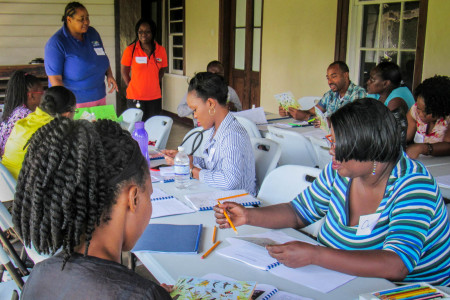
Seville Great House in the parish of St. Ann, Jamaica is a place suffused with history on the site of the island’s first capital, Sevilla La Nueva. The property of over 300 acres reflects the changing fortunes of colonial powers, and the sugar industry. Like much of Jamaica’s past, its history – stretching back to the Tainos, whom Christopher Columbus first encountered there in 1494 – has its dark side. The Spaniards brought the first African slaves to the estate as early as 1513.
Yet, on a bright, windy Friday morning the mood was decidedly upbeat, as teachers from eleven St. Ann schools gathered for a BirdSleuth workshop on the long, sweeping verandah of the Great House, overlooking the Caribbean Sea. The focus was not on the cultural heritage but on the natural history of Jamaica, and specifically its endemic birds.
The National Planning & Environment Agency (NEPA) organized the workshop, with experienced Senior Public Education and Community Outreach Officer Ava Tomlinson at the helm. Her colleague Patrice Gilpin – who was involved for the first time in the BirdSleuth Caribbean curriculum – was her able assistant, while Renieve Rhoden ensured the group was nourished, with curry goat and more.
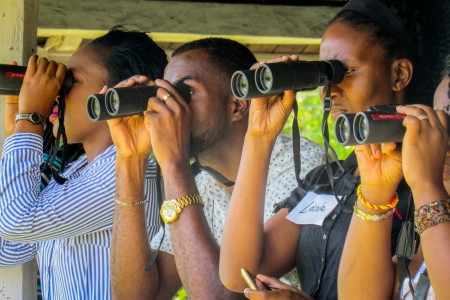
The teachers were not sitting down all day. They lined up along the verandah for a binocular practice session, comparing notes, adjusting their sights and pointing out birds to focus on. An American Kestrel posed obligingly on a post, Turkey Vultures soared on the breeze overhead, and Cattle Egrets strutted on the wide lawns. Venturing into the wooded areas fringing the property, workshop participants practiced spotting birds and training their binoculars on them. Among the endemic birds they saw and heard were the Red-Billed Streamertail and the Jamaican Crow, or “Jabbering Crow.”
The “Sound Map” exercise involved the participants breaking up into small groups, sitting under trees and listening for bird sounds and “mapping” them. A much noisier exercise was the acting out of the perilous journeys of migratory birds, with the obstacles confronting them, in the shade of a large ackee tree. The energetically flapping, determined “birds” encountered equally determined “wind turbines” and other dangers. Some – but not all – managed to reach their destination.
Ms. Tomlinson, herself a Game Warden, took care to outline the local laws that protect birds. There is a relatively short and tightly regulated bird-shooting season in Jamaica. Ms. Tomlinson emphasized the areas where shooting is not allowed, including forest and game reserves.
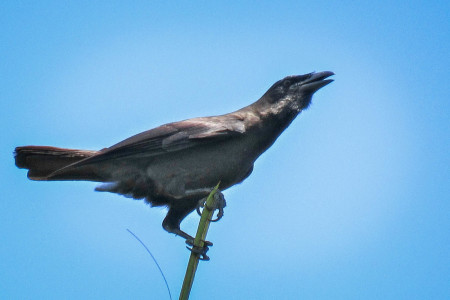
At the end of the day the teachers considered different ways in which they could use elements of the BirdSleuth curriculum to enhance their lessons. Those who taught general science said they could show how the birds use the elements – pointing to the “John Crows” (Turkey Vultures) that rise on air currents, for example. An English teacher said she could use birds to illustrate adjectives and prepositions – describing the bird and its position (up, under, on…?) A teacher of technical drawing and a mathematics teacher said drawing birds could show measurements and proportions. Of course, there are also many possibilities in art, music and drama.
During the day, the teachers also began to recognize the value of birding excursions for their young students. Some are very “hyper” and hard to calm down, they said – especially the boys, who usually enjoy outdoor activities. An hour or so listening for and watching birds (and not firing at them with a slingshot!) would very likely have positive effects on the children’s behavior, teaching them to quiet down, be patient and pay attention to their natural surroundings.
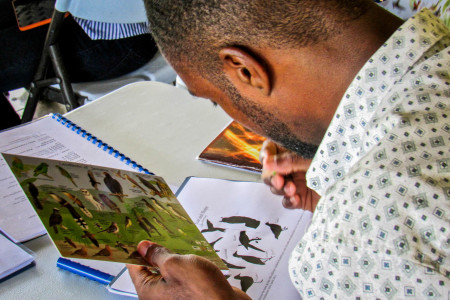
Here are some reactions to the training:
Avroy Harris, Exchange All Age School: In particular, I enjoyed the activity in which we used the bird map. This [can be] instrumental in teaching our students directions – north, south and so on.
Kenroy Brooks, Principal, Chalky Hill All Age School: I think this is a good tool to take back to my school – especially for the boys…This will be very beneficial to them, to enhance their learning.
Carol Brown, Mathematics Teacher, Bamboo Primary & Junior High School: The introduction of the BirdSleuth can really help the students in Math: Map reading, counting the birds, measuring the length of the birds in flight…
Dionne Thompson, Epworth Primary School: I loved this workshop…I love birds! As a child growing up…in my room through the window there was this hummingbird. It would come into my room and I would open my window for the bird to come in…As a child, up until an adult – I love birds.
Sabrina, Camperdown All Age: [The students] could make a sound collage when they go outside with the different sounds, after they have learned “which is which”… I am looking forward to early mornings when they can go out and see which birds they can find.
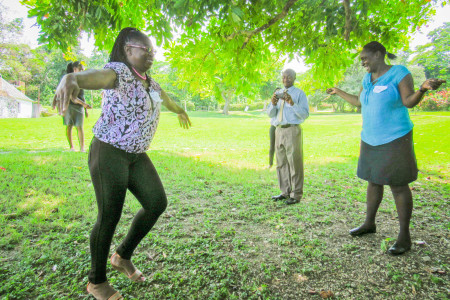
Trainer Ava Tomlinson thought the workshop went well. She said all the teachers were enthusiastic, finding no difficulty in identifying areas of the curriculum where they could integrate the BirdSleuth lessons. She added that the practical aspects of the learning and observing the birds would be greatly enhanced when she handed over the kits for students and teachers. NEPA will continue to support the teachers and monitor progress with the curriculum. After two workshops (one took place in Trelawny last October) she wants to focus on capacity building for the teachers, so that they can fully implement the curriculum.
Ms. Tomlinson believes that Jamaica’s 28 endemic species of birds are a part of the island’s cultural, economic and social fabric. During the current Caribbean Endemic Bird Festival, NEPA, partnering with the Southern Trelawny Environmental Agency, is spearheading a bird festival with students from eleven local schools on May 13. NEPA now has 20 schools on board with BirdSleuth, while non-governmental organizations (Jamaica Environment Trust and Caribbean Coastal Area Management Foundation) have more.
NEPA’s Patrice Gilpin mused that many stories she hears about the destruction of the environment in Jamaica are depressing, focusing on the “negatives.” It’s important to talk about the good things, she feels: to encourage an appreciation of nature and thus the need for conservation.
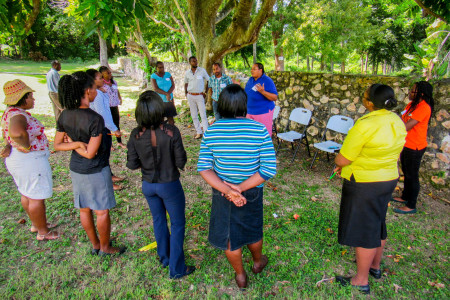
Meanwhile, the birds drew attention to themselves with a dramatic display, which occurred two or three times during the afternoon. A Red-Tailed Hawk (“Chicken Hawk”) dipped too low over the sweeping lawn. Two Jamaican Crows pursued it furiously all around the building, with continuous loud croaks. The hawk itself responded with its high-pitched, eerie cries.
As Jamaicans would say, there was “nuff excitement” as teachers grabbed their binoculars to follow the high-speed chase. While workshop participants left satisfied, we sensed that the mid-air battle was not yet settled, and might continue tomorrow in the skies over Seville Great House.
By Emma Lewis, Blogger, Writer and Online Activist, based in Kingston, Jamaica. Follow Emma at Petchary’s Blog—Cries from Jamaica.
BirdSleuth Caribbean is an inquiry-based science curriculum that engages youth in scientific study and real world data collection. The program encourages kids to answer their own question about nature using the scientific process. It will get your students outdoors, connecting with nature by focusing on the fascinating sights, sounds and behaviors of birds. BirdSleuth Caribbean was developed by BirdsCaribbean in partnership with the Cornell Lab of Ornithology. You can download the curriculum and accompanying materials here. Ava Tomlinson and other educators from around the Caribbean attended an international training workshop in Nassau, Bahamas to learn how to use the curriculum and receive workshop kits to implement the project in their home countries. For more information on the program, contact Lisa Sorenson (Lisa.Sorenson@BirdsCaribbean.org).
